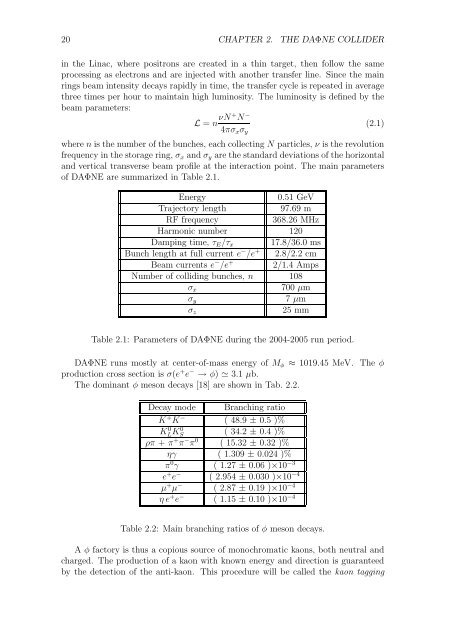Universit`a degli studi Roma Tre Measurement of the KL meson ...
Universit`a degli studi Roma Tre Measurement of the KL meson ...
Universit`a degli studi Roma Tre Measurement of the KL meson ...
Create successful ePaper yourself
Turn your PDF publications into a flip-book with our unique Google optimized e-Paper software.
20 CHAPTER 2. THE DAΦNE COLLIDER<br />
in <strong>the</strong> Linac, where positrons are created in a thin target, <strong>the</strong>n follow <strong>the</strong> same<br />
processing as electrons and are injected with ano<strong>the</strong>r transfer line. Since <strong>the</strong> main<br />
rings beam intensity decays rapidly in time, <strong>the</strong> transfer cycle is repeated in average<br />
three times per hour to maintain high luminosity. The luminosity is defined by <strong>the</strong><br />
beam parameters:<br />
L = n νN+ N −<br />
(2.1)<br />
4πσxσy<br />
where n is <strong>the</strong> number <strong>of</strong> <strong>the</strong> bunches, each collecting N particles, ν is <strong>the</strong> revolution<br />
frequency in <strong>the</strong> storage ring, σx and σy are <strong>the</strong> standard deviations <strong>of</strong> <strong>the</strong> horizontal<br />
and vertical transverse beam pr<strong>of</strong>ile at <strong>the</strong> interaction point. The main parameters<br />
<strong>of</strong> DAΦNE are summarized in Table 2.1.<br />
Energy 0.51 GeV<br />
Trajectory length 97.69 m<br />
RF frequency 368.26 MHz<br />
Harmonic number 120<br />
Damping time, τE/τx<br />
17.8/36.0 ms<br />
Bunch length at full current e − /e + 2.8/2.2 cm<br />
Beam currents e − /e + 2/1.4 Amps<br />
Number <strong>of</strong> colliding bunches, n 108<br />
σx<br />
700 µm<br />
σy<br />
7 µm<br />
25 mm<br />
σz<br />
Table 2.1: Parameters <strong>of</strong> DAΦNE during <strong>the</strong> 2004-2005 run period.<br />
DAΦNE runs mostly at center-<strong>of</strong>-mass energy <strong>of</strong> Mφ ≈ 1019.45 MeV. The φ<br />
production cross section is σ(e + e − → φ) ≃ 3.1 µb.<br />
The dominant φ <strong>meson</strong> decays [18] are shown in Tab. 2.2.<br />
Decay mode Branching ratio<br />
K + K− ( 48.9 ± 0.5 )%<br />
K0 LK0 S ( 34.2 ± 0.4 )%<br />
ρπ + π + π−π0 ( 15.32 ± 0.32 )%<br />
ηγ ( 1.309 ± 0.024 )%<br />
π0γ ( 1.27 ± 0.06 )×10−3 e + e− ( 2.954 ± 0.030 )×10−4 µ + µ − ( 2.87 ± 0.19 )×10−4 η e + e− ( 1.15 ± 0.10 )×10−4 Table 2.2: Main branching ratios <strong>of</strong> φ <strong>meson</strong> decays.<br />
A φ factory is thus a copious source <strong>of</strong> monochromatic kaons, both neutral and<br />
charged. The production <strong>of</strong> a kaon with known energy and direction is guaranteed<br />
by <strong>the</strong> detection <strong>of</strong> <strong>the</strong> anti-kaon. This procedure will be called <strong>the</strong> kaon tagging
















